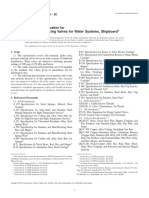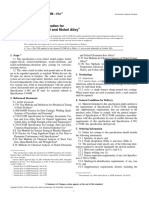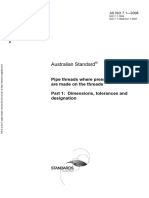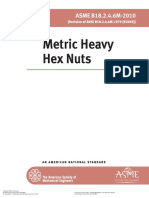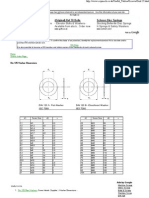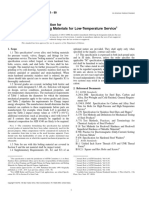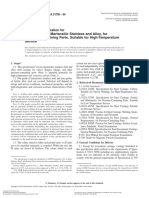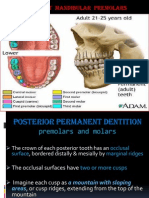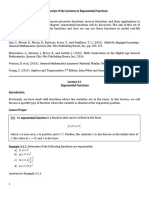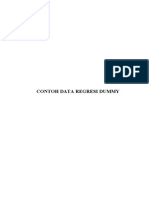Sa 325 PDF
Sa 325 PDF
Uploaded by
Mo'men Abu-SmaihaCopyright:
Available Formats
Sa 325 PDF
Sa 325 PDF
Uploaded by
Mo'men Abu-SmaihaOriginal Title
Copyright
Available Formats
Share this document
Did you find this document useful?
Is this content inappropriate?
Copyright:
Available Formats
Sa 325 PDF
Sa 325 PDF
Uploaded by
Mo'men Abu-SmaihaCopyright:
Available Formats
SPECIFICATION FOR STRUCTURAL BOLTS,
--`,,```,,,,````-`-`,,`,,`,`,,`---
STEEL, HEAT TREATED, 120 /105 KSI MINIMUM
TENSILE STRENGTH
SA-325
(Identical with ASTM Specification A 325-00 except for the deletion of the term “private label distributor” in 16.1 and 16.5.)
1. Scope 1.4 The following safety hazards caveat pertains only
1.1 This specification covers two types of quenched to the test methods portion, Section 10, of this specifica-
and tempered steel structural bolts having a minimum tion: This standard does not purport to address all of the
tensile strength of 120 ksi for sizes 1.0 in. and less and safety concerns, if any, associated with its use. It is the
105 ksi for sizes over 1.0 to 11⁄2 in., inclusive. responsibility of the user of this standard to establish
appropriate safety and health practices and determine
1.2 The bolts are intended for use in structural connec-
the applicability of regulatory limitations prior to use.
tions. These connections are covered under the require-
ments of the Specification for Structural Joints Using
ASTM A 325 or A 490 Bolts, approved by the Research
Council on Structural Connections of the Engineering 2. Referenced Documents
Foundation. 2.1 ASTM Standards:
A 153 Specification for Zinc Coating (Hot-Dip) on Iron
1.3 The bolts are furnished in sizes 1⁄2 to 11⁄2 in., and Steel Hardware
inclusive. They are designated by type, denoting chemical A 194 /A 194M Specification for Carbon and Alloy Steel
composition as follows: Nuts for Bolts for High-Pressure and High-Tempera-
Type Description ture Service
Type 1 Medium carbon, carbon boron, or medium carbon A 242 /A 242M Specification for High-Strength Low-
alloy steel. Alloy Structural Steel
Type 2 Withdrawn in November 1991. A 449 Specification for Quenched and Tempered Steel
Type 3 Weathering steel. Atmospheric corrosion resistance and Bolts and Studs
weathering characteristics are comparable to that of A 490 Specification for Heat-Treated Steel Structural
steels in Specifications A 242 /A 242M, A 588 /A Bolts, 150 ksi Minimum Tensile Strength
588M, and A 709 /A 709M. The atmospheric corrosion
A 563 Specification for Carbon and Alloy Steel Nuts
resistance of these steels is substantially better than
that of carbon steel with or without copper addition A 588 /A 588M Specification for High-Strength Low-
(see 5.2). When properly exposed to the atmosphere, Alloy Structural Steel with 50 ksi [345 MPa] Minimum
these steels can be used bare (uncoated) for many Yield Point to 4 in. [100 mm] Thick
applications. A 709 / A 709M Specification for Carbon and High-
Strength Low-Alloy Structural Steel Shapes, Plates,
NOTE 1 — Bolts for general applications, including anchor bolts, are and Bars and Quenched-and-Tempered Alloy Struc-
covered by Specification A 449. Also refer to Specification A 449 for
tural Steel Plates for Bridges
quenched and tempered steel bolts and studs with diameters greater
than 11⁄2 in., but with similar mechanical properties. A 751 Test Methods, Practices, and Terminology for
NOTE 2 — A complete metric companion to Specification A 325
Chemical Analysis of Steel Products
has been developed — Specification A 325M; therefore, no metric B 695 Specification for Coatings of Zinc Mechanically
equivalents are presented in this specification. Deposited on Iron and Steel
537
Copyright ASME International
Provided by IHS under license with ASME
No reproduction or networking permitted without license from IHS Not for Resale
SA-325 2004 SECTION II
D 3951 Practice for Commercial Packaging 3.1.8 Zinc Coating — Specify the zinc coating pro-
F 436 Specification for Hardened Steel Washers cess required, for example, hot dip, mechanically depos-
F 606 Test Methods for Determining the Mechanical ited, or no preference (see 4.3).
Properties of Externally and Internally Threaded Fas- 3.1.9 Other Finishes — Specify other protective
teners, Washers, and Rivets finish, if required.
F 788 /F 788M Specification for Surface Discontinuities
of Bolts, Screws, and Studs, Inch and Metric Series 3.1.10 Test reports, if required (see Section 14).
F 959 Specification for Compressible-Washer-Type 3.1.11 Special requirements.
Direct Tension Indicators for Use with Structural Fas-
teners NOTE 3 — A typical ordering description follows: 1000 pieces 1 in.
dia ⴛ 4 in. long Heavy Hex Structural Bolt, Type 1 ASTM A 325-XX;
G 101 Guide for Estimating the Atmospheric Corrosion
each with one Hardened Washer, ASTM F 436 Type 1; and one Heavy
Resistance of Low-Alloy Steels Hex Nut, ASTM A 563 Grade DH. Each component hot dip zinc coated.
Nuts lubricated.
2.2 ANSI /ASME Standards:
B1.1 Unified Screw Threads 3.2 Recommended Nuts:
B18.2.1 Square and Hex Bolts and Screws 3.2.1 Unless otherwise specified, all nuts used on
B18.18.3M Inspection and Quality Assurance for Special these bolts shall conform to the requirements of Specifi-
Purpose Fasteners cation A 194 /A 194M or A 563, shall be heavy hex, and
2.3 Military Standard: shall be of the class and surface finish for each type of
MIL-STD 105 Sampling Procedure and Tables for bolt as follows:
Inspection by Attributes Bolt Type and Finish Nut Class and Finish
1, plain (noncoated) A 563-C, C3, D, DH,
DH3, plain
3. Ordering Information A 194-2, 2H, plain
3.1 Orders for bolts under this specification shall 1, zinc coated A 563-DH, zinc coated
include the following: A 194-2H, zinc coated
(see 3.2.2)
3.1.1 Quantity (number of pieces of bolts and acces-
3, plain A 563-C3, DH3, plain
sories).
3.1.2 Size, including nominal bolt diameter and 3.2.2 When Specification A 194 /A 194M Gr. 2H
length (see 3.1.3.1). zinc-coated nuts are supplied, the zinc coating, overtap-
3.1.2.1 Bolts threaded full length, specify Sup- ping, lubrication, and rotational capacity testing shall be
plementary Requirement S1. in accordance with Specification A 563.
3.1.3 Name of product. 3.3 Unless otherwise specified, all washers used on
these bolts shall conform to the requirements of Specifi-
3.1.3.1 Heavy hex structural bolts are supplied
cations F 436 or F 959 and shall be of a surface finish
unless otherwise specified. For bolts other than heavy hex
for each type of bolt as follows:
structural, dimensional requirements must be specified on
the purchase inquiry and order. The thread length may Bolt Type and Finish Washer Finish
not be changed except as provided in Supplementary 1, plain (uncoated) plain (uncoated)
Requirement S1. 1, zinc coated zinc coated
3.1.4 Type of bolt, that is Type 1 or 3. 3, plain weathering
steel, plain
3.1.5 ASTM designation and year of issue.
3.1.6 Other components such as nuts, washers, and
washer type direct tension indicators, if required.
4. Materials and Manufacture
3.1.6.1 When such other components are speci-
fied to be furnished, also state “nut washers, and direct 4.1 Heat Treatment — Bolts shall be heat treated by
tension indicators, or combination thereof shall be fur- quenching in a liquid medium from above the austenitiz-
nished by lot number.” ing temperature and then tempering by reheating to a
temperature of at least 800°F.
3.1.7 Accessories such as nuts and washers, when
required. 4.2 Threading — Threads of bolts may be cut or rolled.
538
Copyright ASME International
Provided by IHS under license with ASME
No reproduction or networking permitted without license from IHS Not for Resale
PART A — FERROUS MATERIAL SPECIFICATIONS SA-325
4.3 Zinc Coatings, Hot-Dip and Mechanically 5.3 Product analyses may be made by the purchaser
Deposited: from finished material representing each lot of bolts. The
4.3.1 When zinc-coated fasteners are required, the chemical composition thus determined shall conform to
purchaser shall specify the zinc-coating process, for the requirements specified in 5.1 or 5.2.
example, hot dip, mechanically deposited, or no pref- 5.4 Heats of steel to which bismuth, selenium, tellu-
erence. rium, or lead has been intentionally added shall not be
4.3.2 When hot-dip is specified, the fasteners shall permitted for bolts.
be zinc coated by the hot-dip process and the coating shall
5.5 For Type 1 bolts made from plain carbon steel
conform to the coating weight /thickness and performance
or alloy steel, heats of steel to which boron has been
requirements of Class C of Specification A 153.
intentionally added shall not be permitted.
4.3.3 When mechanically deposited is specified,
the fasteners shall be zinc coated by the mechanical depo- 5.6 Compliance with 5.4 and 5.5 shall be based on
sition process and the coating shall conform to the coating certification that heats of steel having any of the listed
weight /thickness and performance requirements of Class elements intentionally added were not used to produce
50 of Specification B 695. the bolts.
4.3.4 When no preference is specified, the supplier 5.7 Chemical analyses shall be performed in accor-
may furnish either a hot-dip zinc coating in accordance dance with Test Methods, Practices, and Terminology
with Specification A 153, Class C, or a mechanically A 751.
deposited zinc coating in accordance with Specification
B 695, Class 50. Threaded components (bolts and nuts)
shall be coated by the same zinc-coating process and the 6. Mechanical Properties
supplier’s option is limited to one process per item with 6.1 Hardness — The bolts shall conform to the hard-
no mixed processes in a lot. ness specified in Table 3.
4.4 Lubrication — When zinc-coated nuts are ordered 6.2 Tensile Properties:
with the bolts, the nuts shall be lubricated in accordance 6.2.1 Bolts having a length of 3 times the diameter
with Specification A 563, Supplementary Requirement or longer (see 6.2.3) shall be tested full size and shall
S1, to minimize galling. conform to the tensile strength and proof load or alterna-
4.5 Secondary Processing — If heat treatment, zinc tive proof load specified in Table 4.
coating, lubrication, or other processing affecting proper- 6.2.2 Bolts having a length less than 3 times the
ties is performed by a subcontractor, the fasteners shall diameter are not subject to tensile tests, except as permit-
be inspected after such processing by the party responsi- ted in 6.2.3.
ble for supplying the fasteners to the user or installer. 6.2.3 Bolts having a length of 2 times the diameter
Heat-treated fasteners shall be tested for all mechanical or longer may be tested full size for tensile properties
properties; hot-dip zinc-coated fasteners for all mechani- whenever test equipment is available. In such cases refer-
cal properties and rotational capacity; mechanically zinc- ence to “3 times the diameter” in Table 3, 6.2.1, and
coated fasteners for rotational capacity; and lubricated 6.2.2 shall be considered to be “2 times the diameter.”
fasteners for rotational capacity.
6.2.4 For bolts on which hardness and tension tests
are performed, acceptance based on tensile requirements
5. Chemical Composition shall take precedence in the event of controversy over
low hardness tests.
5.1 Type 1 bolts shall be plain carbon steel,
carbon /boron steel, or alloy steel, at the manufacturer’s 6.3 Rotational Capacity Test:
option, conforming to the chemical composition specified 6.3.1 Definition — The rotational capacity test is
in Table 1. intended to evaluate the presence of a lubricant, the effi-
5.2 Type 3 bolts shall be weathering steel and shall ciency of the lubricant and the compatability of assem-
conform to one of the chemical compositions specified blies as represented by the components selected for
in Table 2. The selection of the chemical composition, testing.
A, B, C, D, E, or F, shall be at the option of the bolt 6.3.2 Requirement — Zinc-coated bolts and zinc
manufacturer. See Guide G 101 for methods of estimating coated and lubricated nuts tested full size in an assembled
the atmospheric corrosion resistance of low alloy steels. joint or tension-measuring device, in accordance with
539
Copyright ASME International
Provided by IHS under license with ASME
No reproduction or networking permitted without license from IHS Not for Resale
SA-325 2004 SECTION II
10.2, shall not show signs of failure when subjected to 7.4 The gaging limit for bolts shall be verified during
the nut rotation in Table 5. The test shall be performed manufacture. In case of dispute, a calibrated thread ring
by the responsible party (see Section 15) prior to shipment gage of the same size as the oversize limit in 7.3 (Class
after zinc coating and lubrication of nuts. X tolerance, gage tolerance plus) shall be used to verify
6.3.3 Acceptance Criteria — The bolt and nut compliance. Assembly of the gage, or the nut described
assembly shall be considered as nonconforming if the above, must be possible with hand effort following appli-
--`,,```,,,,````-`-`,,`,,`,`,,`---
assembly fails to pass any one of the following specified cation of light machine oil to prevent galling and damage
requirements: to the gage. These inspections, when performed to resolve
6.3.3.1 Inability to install the assembly to the disputes, are to be performed at the frequency described
nut rotation in Table 5. in Table 6.
6.3.3.2 Inability to remove the nut after installing
to the rotation specified in Table 5.
8. Workmanship
6.3.3.3 Shear failure of the threads as determined
by visual examination of bolt and nut threads following 8.1 Surface discontinuity limits shall be in accordance
removal. with Specification F 788 /F 788M.
6.3.3.4 Torsional or torsional tension failure of
the bolt. Elongation of the bolt, in the threads between
the nut and bolt head, is to be expected at the required 9. Number of Tests and Retests
rotation and is not to be classified as a failure. 9.1 Testing Responsibility:
9.1.1 Each lot shall be tested by the manufacturer
7. Dimensions prior to shipment in accordance with the production lot
7.1 The bolts shall be full-body conforming to the identification control quality assurance plan in 9.2
dimensions for heavy hex structural bolts specified in through 9.6.
ANSI /ASME B18.2.1.
9.1.2 When bolts are furnished by a source other
7.1.1 Heavy hex structural bolts shall be supplied, than the manufacturer, the responsible party as defined
unless otherwise specified. For bolts other than Heavy in 15.1 shall be responsible for assuring all tests have been
Hex Structural, dimensional requirements must be speci- performed and the bolts comply with the requirements of
fied on the purchase inquiry and order. The thread length this specification (see 4.5).
may not be changed except as provided in Supplementary
Requirement S1. Special thread lengths can be ordered 9.2 Purpose of Lot Inspection — The purpose of a
under Specification A 449. production lot inspection program is to ensure that each
7.2 Threads shall be the Unified Coarse Thread Series lot conforms to the requirements of this specification. For
as specified in ANSI /ASME B1.1, and shall have Class such a plan to be fully effective it is essential that second-
2A tolerances. When specified, 8-pitch thread series may ary processors, distributors, and purchasers maintain the
be used on bolts over 1 in. in diameter. identification and integrity of each lot until the product
is installed.
7.3 Unless otherwise specified, bolts to be used with
nuts or tapped holes which have been tapped oversize, 9.3 Production Lot Method — All bolts shall be pro-
in accordance with Specification A 563, shall have Class cessed in accordance with a lot identification-control
2A threads before hot-dip or mechanically deposited zinc quality assurance plan. The manufacturer, secondary
coating. After zinc coating, the maximum limit of pitch processors, and distributors shall identify and maintain
and major diameter may exceed the Class 2A limit by the integrity of each production lot of bolts from raw-
the following amount: material selection through all processing operations and
Diameter, in.A Oversize Limit, in.A treatments to final packing and shipment. Each lot shall
1
⁄4 0.016 be assigned its own lot-identification number, each lot
5
⁄16, 3⁄8 0.017 shall be tested, and the inspection test reports for each
7
⁄16, 1⁄2 0.018 lot shall be retained.
9
⁄16 to 3⁄4 incl. 0.020
7
⁄8 0.022 9.4. Production Lot Definition — A production lot, for
1.0 to 11⁄4 incl. 0.024 purposes of assigning an identification number and from
13⁄8, 11⁄2 0.027
which test samples shall be selected, shall consist of all
A
These values are the same as the overtapping required for zinc-coated bolts processed essentially together through all operations
nuts in Specification A 563. to the shipping container that are of the same nominal
540
Copyright ASME International
Provided by IHS under license with ASME
No reproduction or networking permitted without license from IHS Not for Resale
PART A — FERROUS MATERIAL SPECIFICATIONS SA-325
size, the same nominal length, and produced from the surfaces of the bolt head and nut. The hole in the joint
same mill heat of steel. shall have the same nominal diameter as the hole in the
washer. The initial tightening of the nut shall produce a
9.5 Number of Tests
load in the bolt not less than 10% of the specified proof
9.5.1 The minimum number of tests from each load. After initial tightening, the nut position shall be
production lot shall conform to the following: marked relative to the bolt, and the rotation shown in
Number of Pieces in Number of Acceptance Table 5 shall be applied. During rotation, the bolt head
Test Production Lot Tests Number shall be restrained from turning.
800 and less 1 0
Hardness 801 to 8,000 2 0
Tensile 8,001 to 35,000 3 0
Proof load 35,001 to 150,000 8 0 11. Visual Inspection for Head Bursts
150,001 and over 13 0
11.1 Requirement — Each lot shall be visually
Rotational 150,000 and less 2 0
inspected for head bursts and shall meet an acceptable
capacity
quality level of 2.5 as specified in Table 7.
Coating 250,000 and less 4 0
weight 11.2 Testing — AQL sampling and inspection shall
Dimensions In accordance with the manufacturer’s standard be conducted in accordance with the sample size, accept-
quality control practices. In the event of dis- ance, and rejection values specified in Table 7. Samples
pute, acceptance shall be based on the require- shall be picked at random.
ments for Final Inspection, Nondestructive
shown in ASME/ANSI B18.18.3M 11.3 Definitions:
Thread fit
Noncoated Same as Dimensions 11.3.1 Burst — A burst is an open break in the metal
Coated In accordance with 7.4 and Table 6 (material). Bursts can occur on the flats or corners of the
Head bursts In accordance with Section 11 and Table 7 heads of bolts.
9.6 When tested in accordance with the required sam- 11.3.2 Defective Bolt — A defective bolt, for the
pling plan, a lot shall be rejected if any of the test speci- purposes of the visual inspection for bursts, shall be any
mens fail to meet the applicable test requirements. bolt that contains a burst in the flat of the head which
extends into the top crown surface of the head (chamfer
circle) or the under-head bearing surface. In addition,
10. Test Methods bursts occurring at the intersection of two wrenching
10.1 Tensile and Hardness: flats shall not reduce the width across corners below the
10.1.1 Tensile and hardness tests shall be conducted specified minimum.
in accordance with Test Methods F 606 using the wedge 11.3.3 Lot — A lot, for the purposes of visual
tension testing of full size product method to determine inspection, shall consist of all bolts of one type having
full size tensile strength. the same nominal diameter and length made from the
10.1.2 Proof load shall preferably be determined same heat of material and by the same production process
using Method 1, Length Measurement. and subsequently submitted for final inspection at one
10.1.3 Fracture shall be in the body or threads of time.
the bolt without any fracture at the junction of the head 11.4 Acceptance Criteria:
and body.
11.4.1 Manufacturer — If the number of defective
10.2 Rotational Capacity — The zinc-coated bolt shall bolts found during inspection by the manufacturer is
be placed in a steel joint or tension measuring device and greater than the acceptance number given in Table 7 for
assembled with a zinc-coated washer and a zinc-coated the sample size, all bolts in the lot shall be visually
and lubricated nut with which the bolt is intended to be inspected and all defective bolts shall be removed and
used. The nut shall have been provided with the lubricant destroyed.
described in the last paragraph of the Manufacturing Pro-
cesses section of Specification A 563. The joint shall be 11.4.2 Purchaser — If the number of defective bolts
one or more flat structural steel plates or fixture stack up found during inspection by the purchaser is greater than
with a total thickness, including the washer, such that 3 the acceptance number given in Table 7 for the sample
to 5 full threads of the bolt are located between the bearing size, the lot shall be subject to rejection.
541
--`,,```,,,,````-`-`,,`,,`,`,,`---
Copyright ASME International
Provided by IHS under license with ASME
No reproduction or networking permitted without license from IHS Not for Resale
SA-325 2004 SECTION II
12. Inspection 14.1.9 Title and signature of the individual assigned
12.1 If the inspection described in 12.2 is required certification responsibility by the company officers.
by the purchaser, it shall be specified in the inquiry and 14.2 Failure to include all the required information
contract or order. on the test report shall be cause for rejection.
12.2 The inspector representing the purchaser shall
have free entry to all parts of the manufacturer’s works,
or supplier’s place of business, that concern the manufac- 15. Responsibility
ture or supply of the material ordered. The manufacturer 15.1 The party responsible for the fastener shall be
or supplier shall afford the inspector all reasonable facili- the organization that supplies the fastener to the purchaser
ties to satisfy him that the material is being furnished in and certifies that the fastener was manufactured, sampled,
accordance with this specification. All tests and inspec- tested, and inspected in accordance with this specification
tions required by the specification that are requested by and meets all of its requirements.
the purchaser’s representative shall be made before ship-
ment, and shall be conducted as not to interfere unneces-
sarily with the operation of the manufacturer’s works or 16. Product Marking
supplier’s place of business. 16.1 Manufacturer’s Identification — All Types 1 and
3 bolts shall be marked by the manufacturer with a unique
identifier to identify the manufacturer.
13. Rejection and Rehearing
16.2 Grade Identification :
13.1 Material that fails to conform to the requirements
of this specification may be rejected. Rejection should 16.2.1 Type 1 bolts shall be marked “A 325.” Addi-
be reported to the manufacturer or supplier promptly and tionally, the bolts may be marked with 3 radial lines 120
in writing. In case of dissatisfaction with the results of degrees apart.
the test, the manufacturer or supplier may make claim 16.2.2 Type 3 bolts shall be marked A 325 with
for a rehearing. the A 325 underlined. The manufacturer may add other
distinguishing marks indicating the bolt is a weathering
type.
14. Certification
16.3 Marking Location and Methods — All marking
14.1 When specified on the purchase order, the manu-
shall be located on the top of the bolt head and may be
facturer or supplier, whichever is the responsible party
either raised or depressed at the manufacturer’s option.
as defined in Section 15, shall furnish the purchaser a
test report which includes the following: 16.4 Acceptance Criteria — Bolts which are not
14.1.1 Heat analysis, heat number, and a statement marked in accordance with these provisions shall be con-
certifying that heats having the elements listed in 5.4 and sidered nonconforming and subject to rejection.
5.5 intentionally added were not used to produce the bolts; 16.5 Type and Manufacturer’s — Identification shall
14.1.2 Results of hardness, tensile, and proof be separate and distinct. The two identifications shall
load tests; preferably be in different locations and, when on the same
level, shall be separated by at least two spaces.
14.1.3 Results of rotational capacity tests. This
shall include the test method used (solid plate or tension-
measuring device); and the lubricant present for zinc-
17. Packaging and Package Marking
coated nuts when shipped with zinc coated bolts;
17.1 Packaging:
14.1.4 Zinc coating measured coating
weight /thickness for coated bolts; 17.1.1 Unless otherwise specified, packaging shall
be in accordance with Practice D 3951.
14.1.5 Results of visual inspection for bursts;
17.1.2 When zinc-coated nuts are included on the
14.1.6 Statement of compliance with dimensional same order as zinc-coated bolts, the bolts and nuts shall
and thread fit requirements; be shipped in the same container.
14.1.7 Lot number and purchase order number; 17.1.3 When special packaging requirements are
14.1.8 Complete mailing address of responsible required, they shall be defined at the time of the inquiry
party; and and order.
542
--`,,```,,,,````-`-`,,`,,`,`,,`---
Copyright ASME International
Provided by IHS under license with ASME
No reproduction or networking permitted without license from IHS Not for Resale
PART A — FERROUS MATERIAL SPECIFICATIONS SA-325
17.2 Package Marking: ordered with A 325 heavy hex structural bolts, the ship-
17.2.1 Each shipping unit shall include or be plainly ping unit shall be marked with the lot number in addition
marked with the following information: to the marking required by the applicable product specifi-
cation;
17.2.1.1 ASTM designation and type;
17.2.1.6 Purchase order number; and
17.2.1.2 Size;
17.2.1.7 Country of origin.
17.2.1.3 Name and brand or trademark of the
manufacturer;
17.2.1.4 Number of pieces; 18. Keywords
17.2.1.5 Lot number; when nuts, washers, or 18.1 bolts; carbon steel; steel; structural; weather-
direct tension indicators, or a combination thereof, are ing steel
TABLE 1
CHEMICAL REQUIREMENTS FOR TYPE 1 BOLTS
Carbon Steel Carbon Boron Steel Alloy Steel
Heat Product Heat Product Heat Product
Element Analysis Analysis Analysis Analysis Analysis Analysis
Carbon 0.30–0.52 0.28–0.55 0.30–0.52 0.28–0.55 0.30–0.52 0.28–0.55
Manganese, min. 0.60 0.57 0.60 0.57 0.60 0.57
Phosporus, max. 0.040 0.048 0.040 0.048 0.035 0.040
Sulfur, max. 0.050 0.058 0.050 0.058 0.040 0.045
Silicon 0.15–0.30 0.13–0.32 0.10–0.30 0.08–0.32 0.15–0.35 0.13–0.37
Boron see 5.5 and 5.6 0.0005–0.003 0.0005–0.003 see 5.5 and 5.6 ...
A A
Alloying elements ... ... ... ...
NOTE:
A
Steel, as defined by the American Iron and Steel Institute, shall be considered to be alloy when the maximum of the range given for the
content of alloying elements exceeds one or more of the following limits: Manganese, 1.65%; silicon, 0.60%; copper, 0.60% or in which a
definite range or a definite minimum quantity of any of the following elements is specified or required within the limits of the recognized field
of constructional alloy steels; aluminum, chromium up to 3.99%, cobalt, columbium, molybdenum, nickel, titanium, tungsten, vanadium, zir-
conium, or any other alloying elements added to obtain a desired alloying effect.
543
--`,,```,,,,````-`-`,,`,,`,`,,`---
Copyright ASME International
Provided by IHS under license with ASME
No reproduction or networking permitted without license from IHS Not for Resale
SA-325 2004 SECTION II
TABLE 2
CHEMICAL REQUIREMENTS FOR TYPE 3 BOLTS
Composition, %
Type 3 Bolts A
Element A B C D E F
Carbon:
Heat analysis 0.33–0.40 0.38–0.48 0.15–0.25 0.15–0.25 0.20–0.25 0.20–0.25
Product analysis 0.31–0.42 0.36–0.50 0.14–0.26 0.14–0.26 0.18–0.27 0.19–0.26
Manganese:
Heat analysis 0.90–1.20 0.70–0.90 0.80–1.35 0.40–1.20 0.60–1.00 0.90–1.20
Product analysis 0.86–1.24 0.67–0.93 0.76–1.39 0.36–1.24 0.56–1.04 0.86–1.24
Phosphorus:
Heat analysis 0.040 max. 0.06–0.12 0.035 max. 0.040 max. 0.040 max. 0.040 max.
Product analysis 0.045 max. 0.06–0.125 0.040 max. 0.045 max. 0.045 max. 0.045 max.
Sulfur:
Heat analysis 0.050 max. 0.050 max. 0.040 max. 0.050 max. 0.040 max. 0.040 max.
Product analysis 0.055 max. 0.055 max. 0.045 max. 0.055 max. 0.045 max. 0.045 max.
Silicon:
Heat analysis 0.15–0.35 0.30–0.50 0.15–0.35 0.25–0.50 0.15–0.35 0.15–0.35
Product analysis 0.13–0.37 0.25–0.55 0.13–0.37 0.20–0.55 0.13–0.37 0.13–0.37
Copper:
Heat analysis 0.25–0.45 0.20–0.40 0.20–0.50 0.30–0.50 0.30–0.60 0.20–0.40
Product analysis 0.22–0.48 0.17–0.43 0.17–0.53 0.27–0.53 0.27–0.63 0.17–0.43
Nickel:
Heat analysis 0.25–0.45 0.50–0.80 0.25–0.50 0.50–0.80 0.30–0.60 0.20–0.40
Product analysis 0.22–0.48 0.47–0.83 0.22–0.53 0.47–0.83 0.27–0.63 0.17–0.43
Chromium:
Heat analysis 0.45–0.65 0.50–0.75 0.30–0.50 0.50–1.00 0.60–0.90 0.45–0.65
Product analysis 0.42–0.68 0.47–0.83 0.27–0.53 0.45–1.05 0.55–0.95 0.42–0.68
Vanadium:
Heat analysis ... ... 0.020 min. ... ... ...
Product analysis ... ... 0.010 min. ... ... ...
Molybdenum:
Heat analysis ... 0.06 max. ... 0.10 max. ... ...
Product analysis ... 0.07 max. ... 0.11 max. ... ...
Titanium:
Heat analysis ... ... ... 0.05 max. ... ...
Product analysis ... ... ... ... ... ...
NOTE:
A
A, B, C, D, E, and F are classes of material used for Type 3 bolts. Selection of a class shall be at the option of the bolt manufacturer.
544
Copyright ASME International
Provided by IHS under license with ASME
No reproduction or networking permitted without license from IHS Not for Resale
PART A — FERROUS MATERIAL SPECIFICATIONS SA-325
TABLE 3
HARDNESS REQUIREMENTS FOR BOLTS
Bolt Length, Brinell Rockwell C
Bolt Size, in. in. Min. Max. Min. Max.
1
⁄2 to 1, incl. Less than 3D A 253 319 25 34
3D and over ... 319 ... 34
11⁄8 to 11⁄2, incl. Less than 3D A 223 286 19 30
3D and over ... 286 ... 30
NOTE:
A
Bolts having a length less than 3 times the diameter are subject only to minimum/maximum hardness.
Such lengths cannot be reasonably tensile tested.
D p Nominal diameter or thread size.
TABLE 4
TENSILE REQUIREMENTS FOR FULL SIZE BOLTS
Alternative
Bolt Size, Proof Load, B Proof Load, B
Threads per Inch Tensile Length Yield
and Series Stress Area, A Strength, B Measurement Strength
Designation in.2 Min., lbf Method Method, Min.
Column 1 Column 2 Column 3 Column 4 Column 5
1
⁄2–13 UNC 0.142 17,050 12,050 13,050
5
⁄8–11 UNC 0.226 27,100 19,200 20,800
3
⁄4–10 UNC 0.334 40,100 28,400 30,700
7
⁄8–9 UNC 0.462 55,450 39,250 42,500
1–8 UNC 0.606 72,700 51,500 55,750
11⁄8–7 UNC 0.763 80,100 56,450 61,800
11⁄8–8 UN 0.790 82,950 58,450 64,000
11⁄4–7 UNC 0.969 101,700 71,700 78,500
11⁄4–8 UN 1.000 105,000 74,000 81,000
13⁄8–6 UNC 1.155 121,300 85,450 93,550
13⁄8–8 UN 1.233 129,500 91,250 99,870
11⁄2–6 UNC 1.405 147,500 104,000 113,800
11⁄2–8 UN 1.492 156,700 110,400 120,850
NOTES:
A
The stress area is calculated as follows:
As p 0.7854 [D − (0.9743/n)]2
where:
As p stress area, in.2,
D p nominal bolt size, and
n p threads per inch.
B
Loads tabulated are based on the following:
Bolt Size, in. Column 3 Column 4 Column 5
1
⁄2 to 1, incl. 120,000 psi 85,000 psi 92,000 psi
11⁄8 to 11⁄2, incl. 105,000 psi 74,000 psi 81,000 psi
545
--`,,```,,,,````-`-`,,`,,`,`,,`---
Copyright ASME International
Provided by IHS under license with ASME
No reproduction or networking permitted without license from IHS Not for Resale
SA-325 2004 SECTION II
TABLE 5
ROTATIONAL CAPACITY TEST FOR ZINC-COATED BOLTS
Nominal Nut Rotation, degrees
Bolt Length, in. (Turn)
Up to and including 4 ⴛ dia 240 (2⁄3)
Over 4 ⴛ dia, but not exceeding 8 ⴛ dia 360 (1)
Over 8 ⴛ dia, but not exceeding 12 ⴛ dia 420 (11⁄6)
Over 12 ⴛ dia Test not applicable
TABLE 6
SAMPLE SIZES AND ACCEPTANCE NUMBERS FOR INSPECTION OF
HOT DIP OR MECHANICALLY DEPOSITED ZINC-COATED THREADS
Lot Size Sample Size A,B Acceptance Number A
2 to 90 13 1
91 to 150 20 2
151 to 280 32 3
281 to 500 50 5
501 to 1,200 80 7
1,201 to 3,200 125 10
3,201 to 10,000 200 14
10,001 and over 315 21
NOTES:
A
Sample sizes of acceptance numbers are extracted from “Single Sampling Plan for Normal Inspec-
tion” Table IIA, MIL-STD-105.
B
Inspect all bolts in the lot if the lot size is less than the sample size.
TABLE 7
SAMPLE SIZES WITH ACCEPTANCE AND
REJECTION NUMBERS FOR INSPECTION OF BURSTS 2.5 AQL
Sample Acceptance
Lot Size Size A,B Number A Rejection No.
2 to 8 2 0 1
9 to 15 3 0 1
16 to 25 5 0 1
26 to 150 20 1 2
151 to 280 32 2 3
281 to 500 50 3 4
501 to 1,200 80 5 6
1,201 to 3,200 125 7 8
3,201 to 10,000 200 10 11
10,001 to 35,000 315 14 15
NOTES:
A
Sample sizes, acceptance numbers, and rejection numbers are extracted from “Single Sampling Plan
for Normal Inspection” Table IIA, MIL-STD-105.
B
Inspect all bolts in the lot if the lot size is less than the sample size.
546
Copyright ASME International
Provided by IHS under license with ASME
No reproduction or networking permitted without license from IHS Not for Resale
PART A — FERROUS MATERIAL SPECIFICATIONS SA-325
SUPPLEMENTARY REQUIREMENTS
The following supplementary requirements shall apply only when specified by the pur-
chaser in the contract or order. Details of these supplementary requirements shall be
agreed upon in writing between the manufacturer and purchaser. Supplementary require-
ments shall in no way negate any requirement of the specification itself.
S1. Bolts Threaded Full Length will permit, shall not exceed the length of 21⁄2 threads
S1.1 Bolts with nominal lengths equal to or shorter for bolt sizes 1 in. and smaller, and 31⁄2 threads for bolt
than four times the nominal bolt diameter shall be sizes larger than 1 in.
threaded full length. Bolts need not have a shoulder, and
the distance from the underhead bearing surface to the S1.2 Bolts shall be marked in accordance with Section
first complete (full form) thread, as measured with a GO 16, except that the symbol shall be A 325 T instead of
thread ring gage, assembled by hand as far as the thread A 325.
547
--`,,```,,,,````-`-`,,`,,`,`,,`---
Copyright ASME International
Provided by IHS under license with ASME
No reproduction or networking permitted without license from IHS Not for Resale
--`,,```,,,,````-`-`,,`,,`,`,,`---
548
Copyright ASME International
Provided by IHS under license with ASME
No reproduction or networking permitted without license from IHS Not for Resale
You might also like
- Cat 3512 Sensor PositionDocument5 pagesCat 3512 Sensor PositionĐoàn Ngọc Đại90% (10)
- PSA Peugeot Citroen - Wiring DiagramsDocument16 pagesPSA Peugeot Citroen - Wiring DiagramsMattH375% (4)
- ASTM A270-98ae1Document5 pagesASTM A270-98ae1NadhiraNo ratings yet
- Pressure-Reducing Valves For Water Systems, ShipboardDocument10 pagesPressure-Reducing Valves For Water Systems, Shipboardreza amiriniaNo ratings yet
- Astm A403Document7 pagesAstm A403mtpiping2572100% (1)
- Bs 3293Document18 pagesBs 3293nguyenmainam0% (1)
- ASME Section II PartA SA193 2007 PDFDocument18 pagesASME Section II PartA SA193 2007 PDFhoustonhimselfNo ratings yet
- Welded UNS N08120, UNS N08800, UNS N08810, and UNS N08811 Alloy TubesDocument3 pagesWelded UNS N08120, UNS N08800, UNS N08810, and UNS N08811 Alloy TubesRed RedNo ratings yet
- 010 Sa29 Sa29mDocument26 pages010 Sa29 Sa29mWeniton OliveiraNo ratings yet
- Valve MaterialsDocument9 pagesValve MaterialsVu Tung LinhNo ratings yet
- Asme B18.12 2001Document19 pagesAsme B18.12 2001Jesse ChenNo ratings yet
- Astm B584-2014Document8 pagesAstm B584-2014labnitzNo ratings yet
- Sfa-5 18Document28 pagesSfa-5 18Armando Lujan VelazquezNo ratings yet
- Metric Continuous and Double End Studs: ASME B18.31.1M-2005Document18 pagesMetric Continuous and Double End Studs: ASME B18.31.1M-2005Joel CieltoNo ratings yet
- Iso 9393 2 2005Document9 pagesIso 9393 2 2005mohanrulesNo ratings yet
- DIN en 10253 4 Corrigendum 2 2009 PDFDocument3 pagesDIN en 10253 4 Corrigendum 2 2009 PDFjirafabg123No ratings yet
- Valves: Guidelines On Terminology For and FittingsDocument30 pagesValves: Guidelines On Terminology For and FittingsNatalyaNo ratings yet
- MSS SP-43 (1991) (Reaffirmed 2001)Document16 pagesMSS SP-43 (1991) (Reaffirmed 2001)Allan SousaNo ratings yet
- BS10 Flange SizesDocument2 pagesBS10 Flange SizesPeter Mc KinleyNo ratings yet
- Astm B575Document5 pagesAstm B575Jota Jacques100% (1)
- DIN Flange 2502-2503 PDFDocument2 pagesDIN Flange 2502-2503 PDFHeru Agus SetyawanNo ratings yet
- Asme B18.2.6 2003Document11 pagesAsme B18.2.6 2003Jesse ChenNo ratings yet
- Mech Malleable Iron Fittings Catalogue PDFDocument12 pagesMech Malleable Iron Fittings Catalogue PDFics companyNo ratings yet
- ASTM B363-06a PDFDocument4 pagesASTM B363-06a PDFScribdNo ratings yet
- Astm A193 A193m 23Document7 pagesAstm A193 A193m 23huicholeNo ratings yet
- GB 700-88Document5 pagesGB 700-88nazarasimNo ratings yet
- Astm A 494Document7 pagesAstm A 494Rodrigo BarrosNo ratings yet
- A494Document7 pagesA494carlos ruizNo ratings yet
- IS 210 - 2009 - Reff2020Document13 pagesIS 210 - 2009 - Reff2020k27571No ratings yet
- Jis G 3458-2020, EngDocument23 pagesJis G 3458-2020, Eng7620383tlNo ratings yet
- Sa 307Document8 pagesSa 307Web LogueandoNo ratings yet
- Astm A537-A537m-95-2000Document4 pagesAstm A537-A537m-95-2000NadhiraNo ratings yet
- ASME B18-2-4-6M Metric Heavy Hex NutsDocument16 pagesASME B18-2-4-6M Metric Heavy Hex Nutsronaldoge100% (1)
- Fitting ASTM A 197 PDFDocument4 pagesFitting ASTM A 197 PDFSusan Sue Berrospi Merino100% (1)
- Din-2848-Pr - de enDocument32 pagesDin-2848-Pr - de enAhmed AbidNo ratings yet
- Astm F 468Document11 pagesAstm F 468Ivan AlanizNo ratings yet
- ASTM A333 Grade 6 Seamless Pipe SupplierDocument4 pagesASTM A333 Grade 6 Seamless Pipe SupplierRajendra FittingsNo ratings yet
- 7 1-2008Document8 pages7 1-2008SAI Global - APACNo ratings yet
- Astm B16 2010Document5 pagesAstm B16 2010brunobassottiNo ratings yet
- Astm A192Document11 pagesAstm A192Marcelo VicentiniNo ratings yet
- JIS G3452 - UpdatedDocument7 pagesJIS G3452 - Updatedngocbinh8x100% (1)
- MSS-SP-104 (1995)Document11 pagesMSS-SP-104 (1995)Islam SolimanNo ratings yet
- Astm A266Document4 pagesAstm A266dneradNo ratings yet
- ASTM A540 A540M 10aDocument3 pagesASTM A540 A540M 10atechnical2No ratings yet
- BS 3799 (74) Specification For Steel Pipe Fittings, Screwed and Socket-Welding For The Petroleum Industry PDFDocument32 pagesBS 3799 (74) Specification For Steel Pipe Fittings, Screwed and Socket-Welding For The Petroleum Industry PDFjodasi300% (1)
- DIN 976-1-2016-09 ENG (英文)Document12 pagesDIN 976-1-2016-09 ENG (英文)Ryan ZhangNo ratings yet
- Asme-B18.31.1m-2008 - (2016) METRIC STUD PDFDocument25 pagesAsme-B18.31.1m-2008 - (2016) METRIC STUD PDFIndana Steel Pvt.LtdNo ratings yet
- Asme B18.2.4.6MDocument16 pagesAsme B18.2.4.6Mmanuneedhi100% (1)
- Din125 WasherDocument2 pagesDin125 WasherHieu TranvanNo ratings yet
- Integrally Reinforced Forged Branch Outlet Fittings - Socket Welding, Threaded, and Buttwelding EndsDocument22 pagesIntegrally Reinforced Forged Branch Outlet Fittings - Socket Welding, Threaded, and Buttwelding Endsssnair85100% (1)
- Astm A320-A320m-99Document8 pagesAstm A320-A320m-99NadhiraNo ratings yet
- Astm A 217 - 04Document4 pagesAstm A 217 - 04Raul Humberto Mora VillamizarNo ratings yet
- A216 16Document4 pagesA216 16arunrathikaNo ratings yet
- Astm A790Document6 pagesAstm A790Nayth Andres Galaz100% (2)
- Hexagon, Socket Head Shoulder Screws (Metric Series) : An American National StandardDocument22 pagesHexagon, Socket Head Shoulder Screws (Metric Series) : An American National StandardJoel CieltoNo ratings yet
- Din 2526 PDFDocument1 pageDin 2526 PDFDaniel TrombimNo ratings yet
- Specification For Forged or Rolled Alloy-Steel Pipe Flanges, Forged Fittings, and Valves and Parts For High-Temperature ServiceDocument21 pagesSpecification For Forged or Rolled Alloy-Steel Pipe Flanges, Forged Fittings, and Valves and Parts For High-Temperature Servicecesar jaramilloNo ratings yet
- Mil S 24149 - 3DDocument8 pagesMil S 24149 - 3DthomasNo ratings yet
- API 622 Valve Packing For Fugitive EmissionsDocument2 pagesAPI 622 Valve Packing For Fugitive EmissionsHungphamphiNo ratings yet
- Stainless Steel Food-Industry Tubes: Seamless & WeldedDocument8 pagesStainless Steel Food-Industry Tubes: Seamless & WeldedspiratubeNo ratings yet
- Specification For Structural Bolts, Steel, Heat Treated, 120 /105 Ksi Minimum Tensile StrengthDocument12 pagesSpecification For Structural Bolts, Steel, Heat Treated, 120 /105 Ksi Minimum Tensile StrengthIsabella RomeroNo ratings yet
- Structural Bolts, Steel, Heat Treated, 120/105 Ksi Minimum Tensile StrengthDocument8 pagesStructural Bolts, Steel, Heat Treated, 120/105 Ksi Minimum Tensile StrengthCarlos Raul Caballero LeonNo ratings yet
- CHF-ENG-SP-L-300 Rev 0 PDFDocument302 pagesCHF-ENG-SP-L-300 Rev 0 PDFMo'men Abu-SmaihaNo ratings yet
- Iee-Astm - Si 10 PDFDocument73 pagesIee-Astm - Si 10 PDFMo'men Abu-SmaihaNo ratings yet
- Sa 307 PDFDocument8 pagesSa 307 PDFMo'men Abu-SmaihaNo ratings yet
- Tech Spec 17Document8 pagesTech Spec 17Mo'men Abu-SmaihaNo ratings yet
- Tech Spec 4Document28 pagesTech Spec 4Mo'men Abu-SmaihaNo ratings yet
- د أ ر 22 - المخططات القياسية للطرق - الجزء الأول PDFDocument148 pagesد أ ر 22 - المخططات القياسية للطرق - الجزء الأول PDFDonald HamiltonNo ratings yet
- A New Algorithm For Parallel Connected-Component Labelling On GpusDocument14 pagesA New Algorithm For Parallel Connected-Component Labelling On GpusMiguel Ramírez CarrilloNo ratings yet
- Exploratory Data AnalysisDocument104 pagesExploratory Data AnalysisSASIKUMAR BNo ratings yet
- A Tutorial On Cascade Control - Control NotesDocument5 pagesA Tutorial On Cascade Control - Control Notesaprk_paulrajNo ratings yet
- Heston Jim GatheralDocument21 pagesHeston Jim GatheralShuo YanNo ratings yet
- Hydrophone Preamplifier Optimization-I Hybrid Microelectronics For Low-NoiseDocument29 pagesHydrophone Preamplifier Optimization-I Hybrid Microelectronics For Low-Noiseuserkan13No ratings yet
- Lower PremolarsDocument32 pagesLower PremolarssaramogharrabiNo ratings yet
- License LicDocument5 pagesLicense LicHyrul Nizam HamediNo ratings yet
- Orientation Jaw RelationDocument42 pagesOrientation Jaw RelationAswitha GanapathyNo ratings yet
- 1SVR500100R0000 CT Erd 12Document4 pages1SVR500100R0000 CT Erd 12Mary RoshmaNo ratings yet
- Journal of Industrial and Engineering ChemistryDocument5 pagesJournal of Industrial and Engineering ChemistryDr. Rajni GargNo ratings yet
- Climate Extremes Indices in The CMIP5 Multimodel Ensemble Part 2.future Climate ProjectionsDocument21 pagesClimate Extremes Indices in The CMIP5 Multimodel Ensemble Part 2.future Climate ProjectionsAshraf RamadanNo ratings yet
- Quiz and Assignment CO4Document1 pageQuiz and Assignment CO4Merceris PacquingNo ratings yet
- 214 Philosophy Exam - TruthDocument8 pages214 Philosophy Exam - TruthChris VisserNo ratings yet
- HDfury 4 SmanualDocument35 pagesHDfury 4 SmanualAndrew WarrenNo ratings yet
- Mca2 4Document4 pagesMca2 4Nav KashyapNo ratings yet
- Assignment 4 - V2Document10 pagesAssignment 4 - V2Kate WoodsNo ratings yet
- Lecture Transcript 3 (Exponential Functions)Document14 pagesLecture Transcript 3 (Exponential Functions)eve lopezNo ratings yet
- DNA Barcode Dan Molekuler Filogeni Turbo Sp. Di Perairan Manokwari Papua BaratDocument12 pagesDNA Barcode Dan Molekuler Filogeni Turbo Sp. Di Perairan Manokwari Papua BaratWelco KarembangNo ratings yet
- Contoh Data Regresi DummyDocument10 pagesContoh Data Regresi DummyBayu SaputraNo ratings yet
- Samson 3241 DSDocument8 pagesSamson 3241 DScecep indraNo ratings yet
- Value Creation in Private Equity by Markus BiesingerDocument81 pagesValue Creation in Private Equity by Markus BiesingerddubyaNo ratings yet
- Elementary Machine Shop Practice Cu31924003961095Document384 pagesElementary Machine Shop Practice Cu31924003961095flandrey100% (5)
- FDR D Evo Datasheet 12-13-10Document4 pagesFDR D Evo Datasheet 12-13-10Story GottiNo ratings yet
- Orthodontic WiresDocument10 pagesOrthodontic Wiresanon_191534692No ratings yet
- Lesson No. 8 in Machine Design 1Document7 pagesLesson No. 8 in Machine Design 1Carl JavierNo ratings yet
- b11327 1 PDFDocument18 pagesb11327 1 PDFGerehNo ratings yet
- 0270029Document6 pages0270029Dee LeeNo ratings yet
- Basic Electrical Engineering R-20Document110 pagesBasic Electrical Engineering R-20Sandhya KumariNo ratings yet



